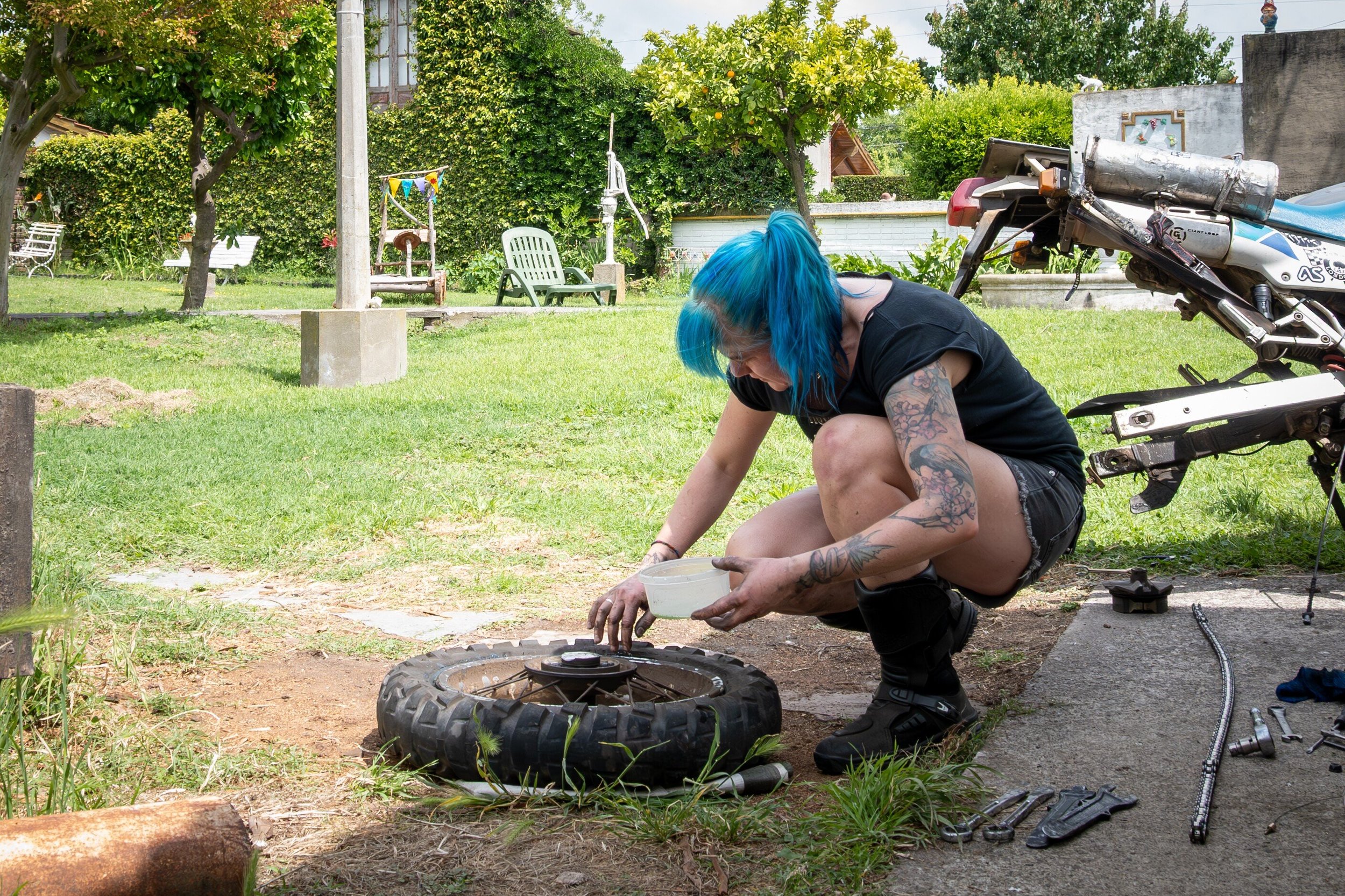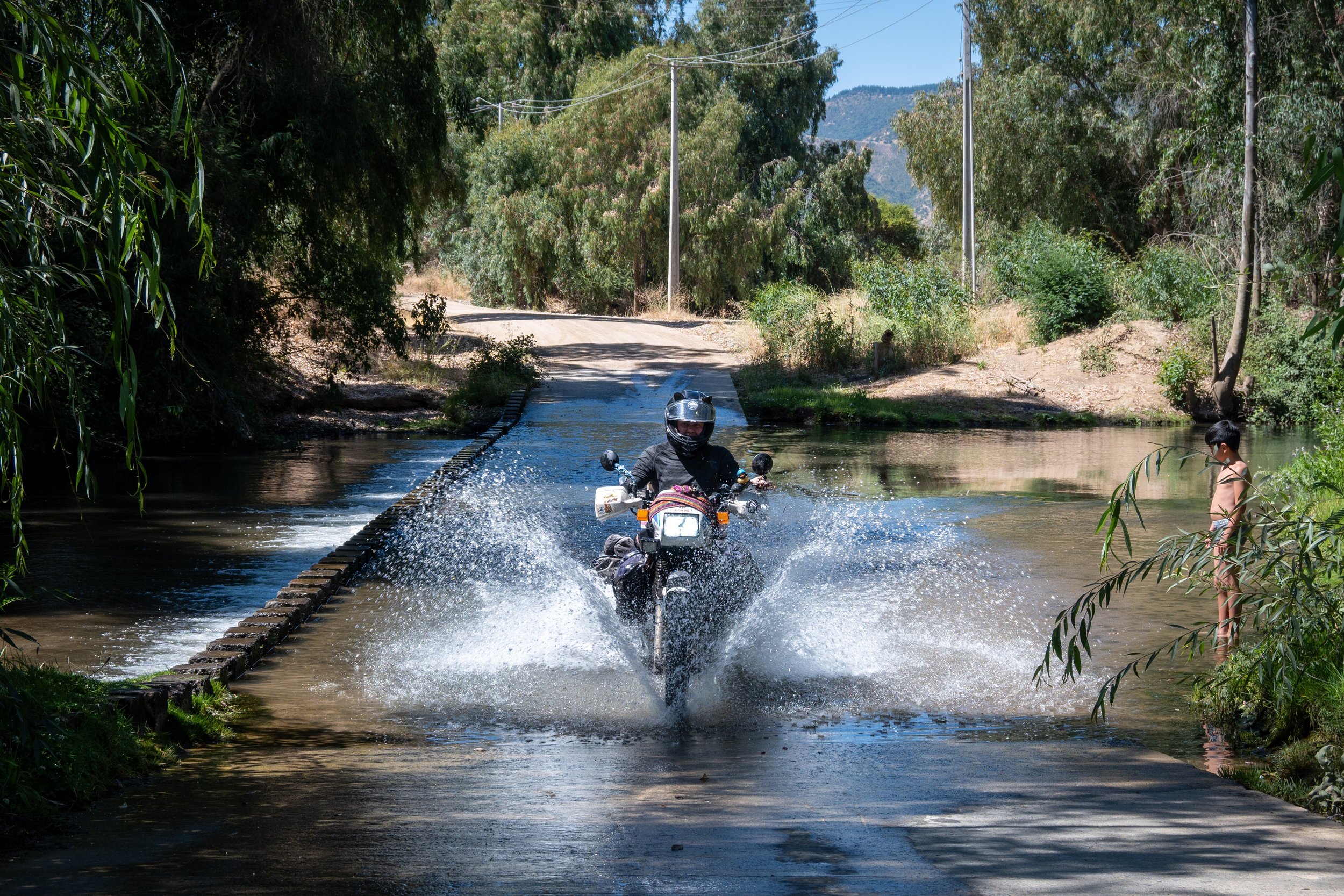Skunk’s Guide to finding the Perfect Adventure Travel Bike
There is no such thing as the one perfect adventure travel motorcycle! But it is possible to find the right adventure bike for you.
For me, since I usually hitch a ride on Maria’s bike’s tank, I prefer one where the handlebars are low, so I can look over them and watch the world go by as we roll along. Ideally it never crashes, since I’m securely strapped in and I can’t just hop off. And if it supports a fridge for cold beers, that’s an added bonus.
But I digress… Below are the things years of moto travel experience have taught us to consider when choosing a bike. And since we’re talking about the perfect adventure travel bike, we’re going on the assumption that it is meant for some sort of adventure travel beyond Starbucks; be that a weekend camping trip, or several years around the world.
In short, the 4 steps to your perfect adventure travel bike are:
Find the bike that is most suited to you and your trip.
Set it up: change out and adjust all the things you can in advance to make the bike as good as you can
Consider what parts and tools special to this bike you bring along
Make a plan of how and where you might get the parts you are not bringing
In detail, here’s our list of considerations to which to apply steps 1-4 above:
Fit for Purpose
First decide if the goal is to find the machine most suited to handling the journey, or whether you want something totally silly, just to see if it can be done (like going round the entire world on a Honda Monkey).
Paved or Off-Road
Will it be mostly easy asphalt, mostly gnarly offroad, or something in between? (Or maybe you’re going to the North pole, and it’s all ice?) Here are things I would consider:
Sufficient ground clearance: off road there things like are rocks, ruts and holes and even on pavement there are things like rim-bending potholes and the infamously high and sudden topes (malicious Mexican speed bumps).
Either way, I highly recommend a bash plate to protect the engine.
Wheel sizes and available tire types: Maria couldn’t get any sort of 50/50 or 80/20 dual-sport tires for her 16 inch rear tire anywhere in Central- and South America and had to get creative about importing them.
Is there ABS and can it be switched off for unpaved sections? Aidan retro-fitted a simple toggle switch to manually turn off the ABS when needed.
Your Physique and Riding Ability
Regrettably I can’t ride my own bike, because I’m too short for all of them. (If you see a mascot-size one, let me know!)
Seat height: It is not impossible to ride ‘too tall’ bikes, and many have mastered it. But realistically, you’ll probably want at the very least your tippy toes to touch the ground. Maria actually prefers a full foot on the ground, so if the bike goes over, her knee is bent enough to kick it back up before she reaches the angle of no return.
Weight: “My bike is too light,” said no one ever. Sure, it is possible to have fun on a big, heavy behemoth, even off-road. And there are reasons for wanting the power a larger engine can provide. On the other hand, the lighter the bike, the easier it is to handle and to pick up. You’ll likely have much more fun if you’re not constantly struggling. So be realistic with what you need and what you will enjoy.
I once watched a petite lady apply all the right techniques, yet try as she might, she could not pick her bike up. And that was in optimal, laid-down-gently-on-the-lawn conditions. ‘Out there’ you often land in awkward positions. Think up-side-down on a rocky slope, stuck in a rut, unable to spin the bike around…
Remoteness and the Availability of Things
Can you get the spare parts you need in the places you are going to? Getting spares for a GS in Europe shouldn’t be a problem. But maybe not so much in Mongolia.
If you plan to buy them as needed, bear in mind that some suppliers don’t ship to certain countries. And some countries, like Argentina, have prohibitively expensive import duties, and may not allow the import of used parts.
Of course, as a last resort, you can always find someone that knows someone with a truck that can take you to where you can find what you need.
Your Mechanical Prowess
Do you mean to do all the motorcycle repairs and maintenance yourself or will you just get a local mechanic to do the work?
Yourself:
Do you have the knowledge? Maria and Aidan learned along the way. At first they had their mechanic at home on speed dial, but with time they got pretty good at repairs and could do all but the most complicated stuff themselves.
Do you have space and weight allowance to bring all the necessary tools? No point bringing those for specialist jobs that you’d need a workshop for anyway, since they’ll hopefully have them there. But it’s worth bringing everything you need for the maintenance you can do roadside.
The mechanic:
Are local mechanics able to fix that particular bike?
Would they know it? No one in the Americas seemed to know the Honda NX250, and Maria always had to work with them, rather than just being able to leave the mechanic to it for jobs she didn’t have the resources to do herself.
Would they have any required specialised tools?
Type of repairs and maintenance
That brings up the next question: different bikes require different kinds of mechanics so you want to consider if whoever is doing the work is able to do it
New bike or old: New bikes have complex electronics and require computers for analysis. Older bikes are simpler and more mechanical. But they likely also need fixing and maintaining more regularly. Maria loves her 1991 Honda NX250. It’s super simple and can be fixed anywhere. But it also needs to be fixed almost everywhere - so we just have to take that into account in our travel plans.
Cast rims or spokes: A cast rim won’t bend, but a particularly sharp-edged pothole might crack it. Finding someone that can weld one is tough. Spoked wheels bend easier, but they are easier and more common to fix. It might be helpful to strap a few spare spokes to the bike’s frame somewhere, so they are available, when you need them.
Tubeless or tube type: punctures are a breeze to fix on tubeless tires, but air loss due to a slight kink in the rim can be a nightmare. So you’ll probably want to consider this in conjunction with the rim decision. Repairing a rim might require an expert, while repairing or changing a punctured tube can be done anywhere, even if it is a hassle.
Shaft drive or chain: A chain requires more regular maintenance, but can easily be changed out. With an automatic chain oiler there’s nothing to worry about apart from the occasional adjustment and a new set of chain and sprockets every now and again. A shaft drive is more set-and-forget. But when they do need fixing or servicing, that’s a more complicated job not every backstreet mechanic can help with.
Or belt drive? To be honest, I know nothing about them, but they seem too feeble for any sort of off-roading adventure. That said, we did meet a mad Russian braaping round the Caucasus Mountains on a ratty belt-driven Harley, and he seemed to be going just about anywhere on that thing. So never say never!
Carburetor or fuel injection: Again the old carbs are mechanically logical and fixable everywhere. But they do require cleaning and things can get finicky. The Honda NX250 one is a simple version and Maria maintained it well, even managing to balance the float and switch out the jets for high altitude. But when it started drawing false air due to some elusive hairline scratch somewhere, we ran into serious problems above 3000 metres. Fuel injection is set-and-forget. It just might be difficult to get to, when it needs replacing and a spare one may not be so easy to come by.
Electric starter and/or kickstart: Electric starter is so much easier of course, but some people swear by having a kick-starter, in case the former doesn’t work. But then you can always push-start. Maria is crap at that, but at least she had Aidan (and sometimes a few locals) to help
The Usual Suspects
Each motorcycle has its own particular niggle - the thing that always goes wrong on every one of that particular model. On the Honda NX250 it’s a fast-tiring cam chain tensioner - so Maria always carries a spare. On the 2005 BMW F650 GS it’s the water pump cogs. So Aidan has spares of those and the clutch cover gasket. He’s changed them out so often now, he can do it roadside. And probably blindfolded, too.
On some bikes, the devoted fans have found a permanent fix, so if you can, do that, before you set off. If not, the rule is: know the niggle, carry the spares, and ideally know how to fix it yourself.
Fun Factor
When all is said and done, this is the most important of all! The more fun the bike, the more you might forgive miscalculations on the points above. But also be aware that getting the above wrong might make the tough times outweigh the good.
The little NX is a super fun bike and Maria is willing to live with hard-to-find spare parts for that. But when things kept going wrong with the engine in Guatemala, she was in tears with thoughts of ditching the bike for another. (Luckily she finally found the cause of all the troubles and happily continued the trip on the NX, making it all the way to Ushuaia.)
Time and Money
I’ve left these til last, because limited amounts of either might heavily influence any of your decisions regarding the above, and few people have plenty of both. The way I approach these, is by starting with the assumption that I have unlimited amounts of both, and choosing the above accordingly, to see what my ideal would be.
Then I assess what concessions I must concede to, trying to stay as close to the ideal as possible. So maybe that beer fridge will have to remain at home and I’ll just pop into local bars instead.















